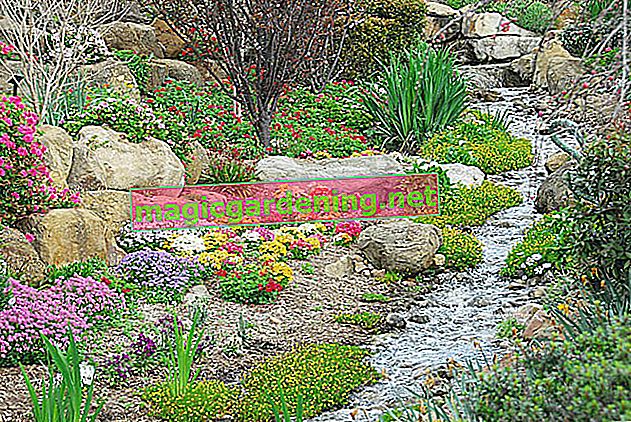
Plant pansies properly
August is the optimal planting time for pansies that have been grown in advance. If you miss this date, put the flowers in the ground in April / May. How to do it right:
- Weed the bed thoroughly, loosen it and work it into fine crumbs
- Dig small pits at a distance of 20 cm and enrich the soil with compost
- Pot the pansies, plant them down to the lower pair of leaves and water
also read
- Plant pansies now!
- The planting time for the pansies
- Pansies - the first heralds of spring on the balcony
An organic mulch layer has a beneficial effect on the roots. In addition, it should be watered repeatedly, especially if there is no rain, so that the tender roots can quickly establish themselves.
Continue reading
Care tips
In order for pansies to show their most beautiful side, extensive care is not required. The beautiful faces value this:
- If the soil dries up, it is poured directly onto the roots
- Fertilize organically every 4 weeks during the growing season until the end of flowering
- Cut out dead pansies for a splendid second bloom
- Light winter protection in the bed is only required when there is clear frost in the form of a leaf or brush cover
If you cultivate the violets in pots, overwintering in the open air is under a bad star. It is better to clear up containers before the first frost and bring them outside when the temperature rises.
Continue reading
Which location is suitable?
The garden pansy prefers a sunny to partially shaded location to perfectly showcase its floral talents. This works best in nutrient-rich and humus soil that is not overly dry. The crumb should be loose and permeable to prevent waterlogging when it rains. In the balcony box and pot, the flower tolerates common compost-based container plant substrate to which you add a little sand or perlite.
Continue reading
The correct planting distance
Arrange pansies in the bed with a plant distance of 15 to 20 cm from each other. In this way, each specimen can develop unhindered without creating unsightly gaps. In the balcony box, reduce the distance between the plants by about 5 cm to create an opulent look.
What soil does the plant need?
Don't let your pansies starve, because plenty of nutrients are required for the colorful flowers. Choose a location with deep, fresh, moist and nutritious soil. If in doubt, optimize the soil quality by adding compost, bark humus, horn shavings (€ 6.39 on Amazon *) or leaf compost. You can loosen up clay-stressed, heavy soil in no time by mixing in a handful of sand.
What is the best time to plant?
Since the majority of pansies thrive as a biennial plant, choosing the right planting date comes into focus. How to do it right:
- Growing in a seed bed or in a greenhouse in June / July, planting in August
- Direct sowing in the bed in July or August
- Ready plants from the garden center are planted in August
Alternatively, grow pansies on the windowsill in February / March to plant them in April / May. These plants, on the other hand, do not have the robust constitution of violets grown outdoors and planted in late summer.
When is the flowering time?
The chosen planting date defines the flowering time. Pansies planted in August will bloom for the first time in October if the weather conditions are suitable, and their flower festival will be repeated next spring from March. If you stay at home in the winter, well-tended violets bloom tirelessly and don't take a winter break. If you cut out dead stems regularly, the distinctive flowers will adorn the garden well into summer. If they had enough opportunity to breed, the two-year-old Violas will be followed by the offspring.
Continue reading
Cut pansies correctly
The violets leave the decision to the gardener. You can let nature run free and remove the pruning from the maintenance program. In this case, you will not like the appearance of the withered, sad drooping flowers. In order to enjoy neat pansies with a never-ending flowering time and a well-kept garden look, the scissors are used like this:
- Regularly clean off dead pansies
- Cut close to the ground at the end of the first flowering period in winter or early spring
In the second year you do the same, whereby the plants are now given the opportunity to multiply from one force by means of seeding. Therefore, do not cut off all the withered flower stalks promptly, but leave about a third in the bed for the formation of seed heads.
Watering the pansy
Pansies prefer a balanced water balance both in the bed and in the planter. A consistently light substrate that dries up a bit in the meantime meets the requirements perfectly. Please note that drought stress is the most common problem for flowers during winter time. You should therefore water on frost-free days when there is no snow in winter.
Fertilize pansies properly
With organic fertilizer you meet the nutritional needs of pansies in an exemplary manner. Compost, horn shavings, (€ 6.39 at Amazon *) guano, (€ 10.44 at Amazon *) bark humus and plant manure contain all the important ingredients for vital growth and a lush flow of flowers. A start fertilization with the beginning of the shoot should be refreshed repeatedly every 4 weeks until the flowering period ends.
Continue reading
Diseases
If there are health problems with pansies, the fungal infection powdery mildew is usually behind it. The plant disease, which is widespread in the garden, manifests itself in the form of a floury-gray patina on the top and bottom of the leaves. Do not hesitate with this symptom, but immediately cut out all infected parts of the plant. Treat the remaining violets repeatedly with a spray of 1 part fresh milk (no UHT milk) and 9 parts water. The lecithin contained in milk has an effective and defensive effect on the fungal spores.
Continue reading
Pests
The juicy leaves and the delicate flowers are unfortunately part of the favorite food of voracious snails. So that the pests that are omnipresent in the home garden do not treat your lovingly grown pansies, you can ward off the plague as follows:
- In the early morning, collect the frozen snails with tongs
- Lay out walking barriers around the bed made of pointed materials such as grit or sawdust
- Collect, dry and scatter coffee grounds as it is toxic to snails
Any snail plague in the garden will be history if you can accommodate Indian running ducks there. If the cute beneficial insects have a garden pond and winter quarters within the fenced-in area, they happily hunt the slimy pests all day long and devour them with great pleasure.
Overwinter
The wild form of the pansy (Viola tricolor) can withstand temperatures down to - 30 degrees Celsius. The resulting garden pansy (Viola wittrockiana) with its diverse varieties is frost-resistant down to - 23 degrees. However, these ideal values apply to typical snowy weather in a partially shaded location in nutrient-rich, permeable soil. If no protective snow cover spreads in freezing frost, we recommend the following precautions:
- Pile garden pansies in the bed with leaves and needles
- Optionally cover with breathable garden fleece
- Water on frost-free days as long as there is no rain or snow
In the balcony box or tub, there is always a need for winter protection so that the small root balls do not freeze through. Cover the vessels with foil and slide a block of wood underneath. Small pots with a diameter of less than 30 cm move to frost-free, light winter quarters.
Continue reading
Propagate pansies
For the ambitious hobby gardener, it is a matter of honor to multiply their most beautiful pansies on their own. The following methods are available for this purpose:
- Harvest the seeds and sow them behind glass or in the bed from June
- Division of the root ball in spring or autumn
- Cut off runners, let root in pots and plant out
Since harvesting the tiny seeds on pansy requires a good dose of tact and a stable nervous system, we recommend purchasing certified seeds from specialist shops. In this case you can also be sure in which color the young plants will thrive, which is not the case with self-harvested seeds.
Continue reading
How do I transplant properly?
Since pansies thrive as biennial plants, the effort of transplanting is neither worthwhile for a change of location nor for rejuvenation. If you want the beautiful faces in a different place in the garden, simply sow the seeds there from July or plant pre-grown specimens from the garden center in August.
Pansies in a pot
Fill a pot with a drainage at the bottom and potting soil over it, pansies will thrive in it without ceasing. How to care for the beautiful faces in a sunny to partially shaded location:
- Pour directly onto the roots when it is dry
- From the beginning of the budding until the end of the flowering period, apply liquid fertilizer every 2-3 weeks
- Regularly clean withered flowers
Before the first frost, move the biennial flowers into the light, frost-free winter quarters. During the winter, water enough so that the root ball does not dry out and do not use fertilizer.
How do pansies differ from horned violets
Since horn violets look like little pansies at first glance, both types of plants are often lumped together. While both flowers are from the violet family, there are significant differences that affect their care.
- Pansies are biennial plants - horned violets thrive for several years
- Pansies grow up to 30 cm high - horn violets rarely reach 20 cm
- The single pansy flower is 6 cm tall - horn violet flowers reach 3 cm in diameter
The flower shape of both types of plants also shows differences. The pansy boasts 4 upward and 1 downward-pointing petals, while on the spurred horny violet 3 petals point towards the sky and 2 towards the ground.
Trivia
It seems to have sprung from the realm of fables and amazes the plant lover. It really does exist, the pansy orchid. Take a look at the tropical flower beauty and the puzzle is already solved. The beautiful Miltonia orchid captivates with flowers that are amazingly similar to a pansy. On the other hand, there is no botanical relationship between the two plant species.
Nice varieties
- Alpine lake: The pansy sets itself in scene with deep, dark blue, giant flowers; Height 15-30 cm
- Evening glow: the burgundy-red flowers with black spots create an elegant look; Height 15-30 cm
- Tasty: The pansy to snack on, with slightly ruffled flowers also a feast for the eyes; Height 15-20 cm
- Joker Poker Face: novelty with rich orange flowers, bordered in dark purple; Height 15-20 cm
- Germania: Extremely decorative variety thanks to double flowers and frilled edges; Height of growth 20 cm








